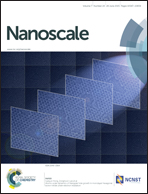Plasma-assisted synthesis and pressure-induced structural transition of single-crystalline SnSe nanosheets†
Abstract
Two-dimensional tin selenide (SnSe) nanosheets were synthesized using a plasma-assisted direct current arc discharge method. The structural characterization indicates that the nanosheets are single-crystalline with an average thickness of ∼25 nm and a lateral dimension of ∼500 nm. The high pressure behaviors of the as-synthesized SnSe nanosheets were investigated by in situ high-pressure synchrotron angle-dispersive X-ray diffraction and Raman scattering up to ∼30 GPa in diamond anvil cells at room temperature. A second-order isostructural continuous phase transition (Pnma → Cmcm) was observed at ∼7 GPa, which is considerably lower than the transition pressure of bulk SnSe. The reduction of transition pressure is induced by the volumetric expansion with softening of the Poisson ratio and shear modulus. Moreover, the measured zero-pressure bulk modulus of the SnSe nanosheets coincides with bulk SnSe. This abnormal phenomenon is attributed to the unique intrinsic geometry in the nanosheets. The high-pressure bulk modulus is considerably higher than the theoretical value. The pressure-induced morphology change should be responsible for the improved bulk modulus.


 Please wait while we load your content...
Please wait while we load your content...